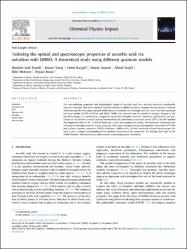Tailoring the optical and spectroscopic properties of ascorbic acid via solvation with DMSO: A theoretical study using different quantum models

Göster/
Erişim
info:eu-repo/semantics/openAccessTarih
2024Yazar
Nasidi, Ibrahim IsahTanış, Emine
Kaygılı, Ömer
Naeem, Samia
Majid, Abdul
Mehnen, Bilel
Bulut, Niyazi
Üst veri
Tüm öğe kaydını gösterKünye
Nasidi, I. I., Tanış, E., Kaygili, O., Naeem, S., Majid, A., Mehnen, B., & Bulut, N. (2023). Tailoring the Optical and Spectroscopic Properties of Ascorbic Acid via Solvation with DMSO: A Theoretical Study using Different Quantum Models. Chemical Physics Impact, 100429.Özet
The anti-oxidizing properties and physiological action of ascorbic acid have recently attracted considerable research attention. This study employs dimethyl sulfoxide (DMSO) solvent to examine the interaction of solvent molecules and the resulting structural modifications in ascorbic acid through trial and error with three quantum solvation models (CPCM, IEFPCM, and SMD). DMSO was selected from the models to analyze changes in the optical bandgap and spectroscopic properties using first-principles methods. Geometry optimization was performed at two different levels of theory: Hartree-Fock (HF) and density functional theory (DFT). The DFT method was employed with a 6–311 G/B3LYP basis set to yield the ground-state energy. The electronic orientation was investigated through potential energy mapping, while spectroscopic analysis encompassed ultraviolet (UV–VIS) and nuclear magnetic resonance (NMR) techniques. Additionally, Fourier transform infrared spectroscopy was used to gain a deeper understanding of the chemical structures of the compound. The findings shed light on the DMSO-Ascorbic acid interactions and revealed structure-property correlation. © 2023 The Author(s)

















